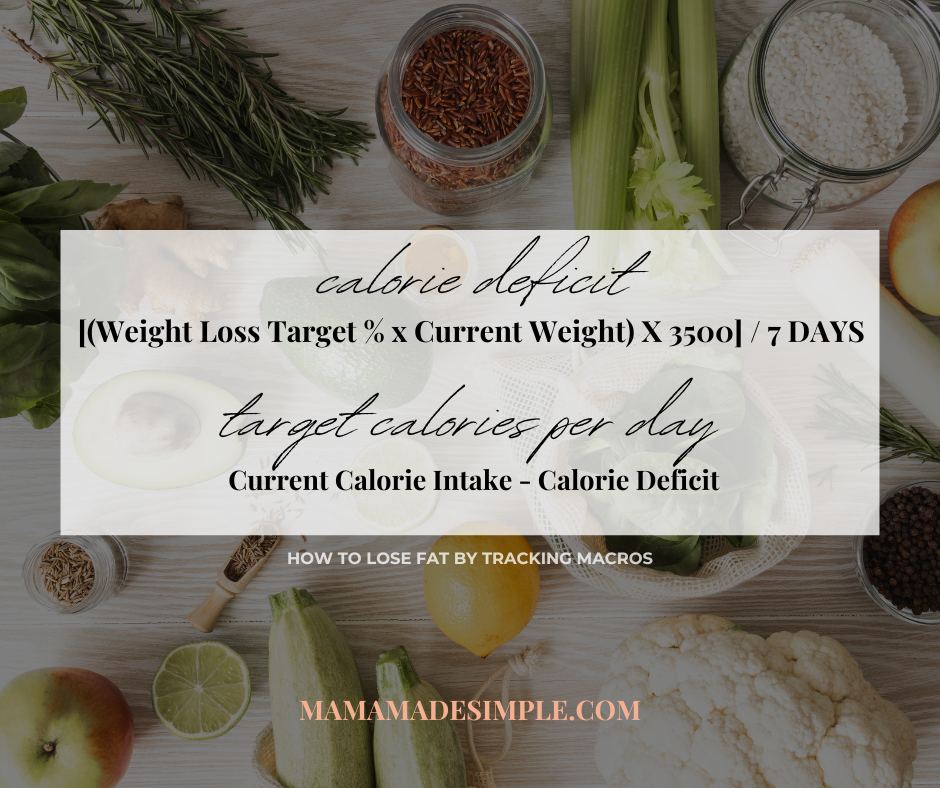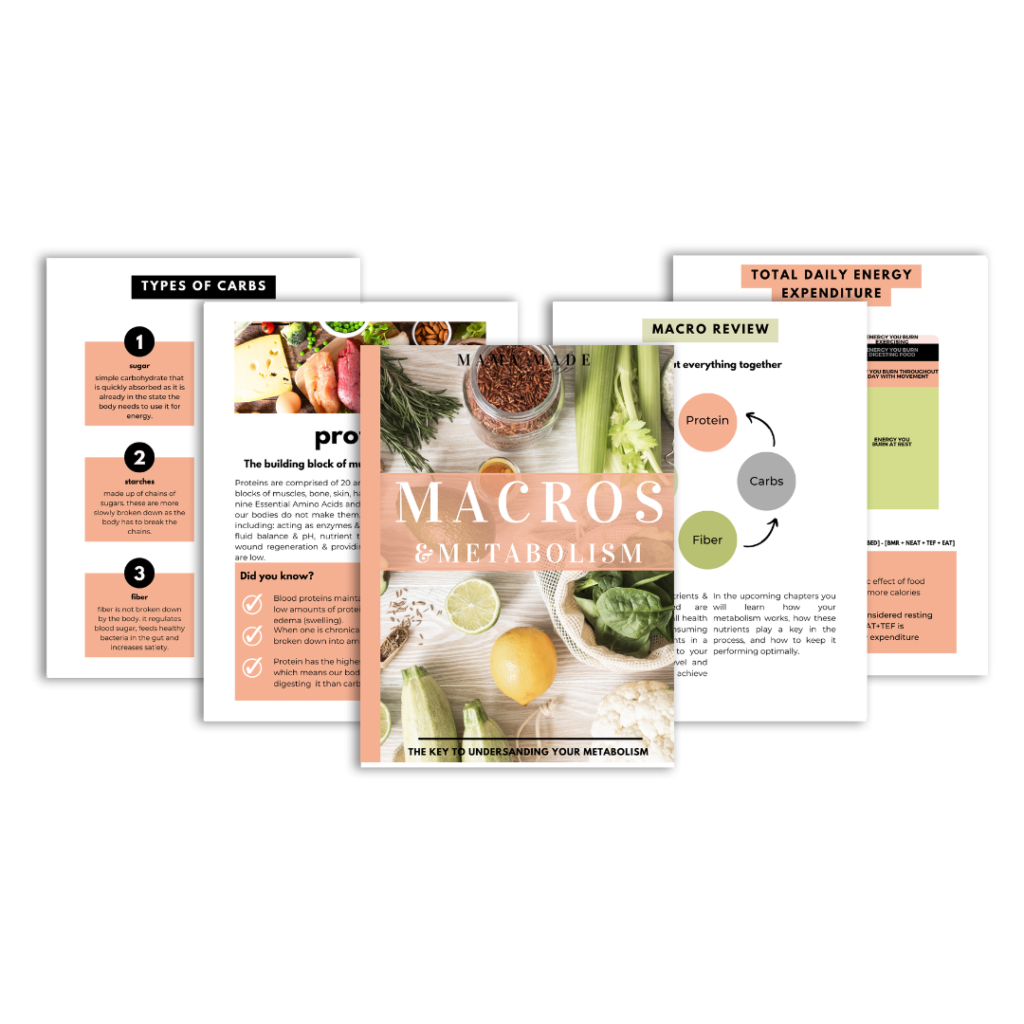What Is a Macros Diet? How to Count Macros for Weight Loss
I remember searching all over Pinterest and Instagram trying to find that one diet that would finally be the one that I would stay consistent with and keep the weight off. I was searching things like tracking macros, how to lose body fat, how to heal your metabolism, lose 20lbs in 60 days, you name it.

But with all the conflicting information on the internet, it was hard to understand exactly how to lose body fat and retain lean muscle mass so I could finally fit back into those skinny jeans in the back of my closet.
I then realized, it really came down to misguided strategies. What had worked for me in the past, didn’t work for me anymore. What I was doing was not enjoyable, did not allow me food freedom and wasn’t sustainable for me.
So, maybe you’re like me and you’ve been eating in a calorie deficit and wondering why you can’t seem to see the number on the scale go down or see any changes in the mirror.
It can make you feel frustrated, especially with all the work you’ve put in.
Today, you’re in luck! I’m going to share a process that will help you lose body fat, retain lean muscle, and finally love the way you look without giving up your favorite foods or feeling like you have to diet forever.
I’ll cover a macros diet, how it works and how you can get started.
Keep reading for more details.
Related: How to Lose Fat and Gain Muscle: The Perfect Strategy for Busy Moms Working Full Time
What Is a Macros Diet?
Macros Diet | Macro Ratios | Counting Macros
A macros diet aims to fuel your body with foods in the correct ratio to support your goals (fat loss, maintenance or muscle gain), help your body function optimally, and allow you to eat any food you would like if it fits in your macronutrient ratio.
The reason that I personally love macros is that I can tailor almost any recipe I want to fit into my macros ratio.
A Macros Diet, or in better words, tracking your macros is a straightforward strategy to losing body fat while retaining lean muscle mass. It’s an especially great tool for us busy moms as we can plan ahead, still be flexible when our schedule demands it, and continue to see the results that we want.
Why Is Tracking Macros Important for Fat Loss?
If you’ve ever searched google or instagram for how to lose weight I’m sure you came across an article or post that talks about being in a calorie deficit.
A calorie deficit is simply eating fewer calories than you burn. When you primarily focus on being in a calorie deficit and are only focused on a set number of calories each day, these calories can come from anywhere. When you focus on calories and not what those calories are made up of, you will lose weight, but that weight will come from organ, bone, fat, and muscle. This can sometimes lead to what people call skinny fat.
So where do macros come in? By focusing on what the calories you are consuming are made up of, you can target body fat specifically instead of losing weight from organ, bone and muscle as well. The ultimate goal of tracking macros is to lose body fat specifically while retaining as much lean muscle as possible. This leads to that toned look you are chasing.
By tracking macros, you’ll be able to understand exactly what you’re eating and then be able to manipulate your macro ratio to reach your desired outcome (losing fat, maintaining your current body composition, or muscle gain).
This way, you will be able to eat foods you love and keep the weight off for good.
Also, tracking your macros gives you the ability to tune into how different foods affect your body and how they make you feel. You’ll also be able to lose body fat in the most efficient way possible .
That means you won’t have to spend years trying diet after diet just to end up gaining it all back and being left wondering what you’re doing wrong.
How to Track Macros for Fat Loss
If tracking macros sounds overwhelming, I get it.
You’re a busy mom working full time while bouncing from practice to games after work. You have limited time to sit down and figure out what you need to do but you know that something has got to change.
So I put together the steps below to break it down for you so you can easily get started with tracking macros.
Step #1. Understanding Your Current Calorie & Macronutrient Intake
This is assessing your current calorie range by tracking the foods you eat for 5-7 days .
Although this may seem like an easy step to skip, it’s actually the most effective way to determine where you should start.
Plus, this will also allow you to start incorporating macro tracking into your daily life. You will get a feel for how it works, how to fit it into your busy schedule, and if it’s right for you.
That means you’ll already know that tracking your macros will be the right fit for you before you dive in. It’s an instant win!
My favorite app to track macros is MacrosFirst. It provides a lot of features for free that other apps charge for like setting custom macro goals and a barcode scanner. They have some great tutorials that show you how to use the app and log your food here.
Step #2. Calorie Deficit or Reverse Diet?
After you have your current calorie intake range you are going to find your maintenance calories. This will determine if you are going to start in a calorie deficit or if you are going to reverse diet back up to maintenance to heal your metabolism.
To do this you are going to go to Precision Nutrition and use their macro calculator to find your maintenance calories. You will only use this tool to find your maintenance calories – you will not use the macros they spit out.
When filling out the calculator you will use Improve Health as you goal, use anything as your preferred eating style, use standard as the macro target, enter 4 as number of meals, pick the appropriate activity level during your work day (most people are light), then pick how often you work out, then click access to get your free guide. It will be emailed to you.
Once you open the email you are going to get your results. You are specifically looking for the section that says Eat _____ Calories per day. This is your maintenance calorie number.
Now you are going to take that maintenance calorie number and compare it to your current calorie intake.
If your maintenance calories are above you current calorie intake then you will need to reverse diet. I will have more information on that in a future blog post and will link it here.
If your maintenance calories are below your current calorie intake, then you can successfully enter a calorie deficit! Continue reading to find out how.
Step #3. Calculating a Calorie Deficit for Fat Loss
So you’ve tracked your calories and macros for at least a week and you’re ready for the next step.
This is where calculating a calorie deficit for fat loss comes in.
A calorie deficit is eating fewer calories than you burn. A calorie deficit can be achieved either by decreasing food intake or increasing calorie burn through exercise, or most commonly a mix of both.
In this example we will just focus just on calculating a calorie deficit through reducing food intake.
The best way to implement this is to start with a smaller calorie deficit. And then as your body adapts to these lower calories, and you see progress stall, then you can slowly reduce your calories or you add in more steps/exercise to increase your deficit without decreasing your food intake.
So how do you calculate a calorie deficit?

(Weight Loss Target % x Current Weight) = Weight Loss Per Week
(Weight Loss Per Week x 3500 Calories) = Size of Weekly Calorie Deficit
(Deficit / 7 Days) = Size of Daily Calorie Deficit
(Current Calorie Intake – Size of Daily Calorie Deficit) = Target Calories each day
I recommend an average weight loss target of .5% – 1.0% of bodyweight per week. What does this mean?
For example:
(1% x 180) = 1.8 Pounds Per Week
(1.8 x 3500) = 6,300 Calories Per Week
(6400/7) = 900 Calorie Deficit Per Day
(2500 – 900) = 1,600 Calories Per Day
The key here is to not spend too much time in a calorie deficit or take your calories lower than your Basal Metabolic Rate (BMR). By doing so your body will begin to adapt to the reduced calories and your progress will stall.
If this is you, click here to watch our free Masterclass on Metabolic Adaptation and how you can overcome it.
This is why I recommend that my clients don’t spend more than 8-12 weeks in Calorie Deficit for optimal metabolic & hormone health.
Step #4. How to Calculate Macros for Fat Loss
Now that we know the size of our calorie deficit, we can calculate our macros.
The Four Macronutrients are Carbohydrates, Protein, Fats and Alcohol. In this post we will focus on the first three.
Carbohydrates – Have 4 Calories per Gram
Protein – Have 4 Calories per Gram
Fat – Have 9 Calories per Gram
For example:
If a food has 5 Carbs, 5 Protein and 5 Fat, then the total Calories for the food would be (5×4) + (5×4) + (5×9) = 85 Calories.
The best way to implement this is to calculate protein first, followed by fats, and then the remaining amount will go to carbs.
I recommend the following Macronutrient Ratio for my clients starting out:
Protein
125 – 145 = 1.5 g per 1 lb of body weight
145 – 165 = 1 g per 1 lb of body weight
165 – 195 = .9 g per 1 lb of body weight
195 – 250 = .8 g per 1 lb of body weight
250 – 300 = .6 g per 1 lb of body weight
Fat
.3 g of fat x current body weight
Carbs
The remaining amount of Calories
The Calculation:
(Body Weight x 1g) = Protein Grams
(Protein Grams x 4) = Protein Calories
(Body Weight x .3g) = Fat Grams
(Fat Grams x 9) = Fat Calories
(Calorie Deficit – Protein Calories – Fat Calories) = Carb Calories
(Carb Calories / 4g) = Carb Grams
For Example:
In the example above our Calorie Deficit is going to be 1,600 Calories per Day.
(180 x 1g) = 180g Protein
(180g x 4) = 720 Calories
(180 x .3g) = 54g Fat
(54 x 9) = 486 Calories
(1600 Calories – 720 Calories – 486 Calories) = 394 Calories
(394 Calories / 4) = 98.5g Carbs
IMPORTANT NOTE: Everyone’s Macro Numbers will be different based on your body weight, activity levels, age, gender, etc. DO NOT USE THESE NUMBERS. This is just an example.
If you would like help calculating your macros, please send me an email to hello@briemerson.com and I will help you get started!
Tips for Fat Loss Success with Tracking Macros
Here are a few tips to help you maximize your results with calculating macros for fat loss:
How to Stay Consistent with Weight Loss
To achieve the best results, you have to remain consistent in your journey. I know that you have probably heard consistency is key over and over. However, if you’re anything like I was, you try so hard to stay consistent but just can’t seem to do it.
When you can finally break free of the idea that you have to be 100% perfect every day on your journey, you begin to enjoy the process along the way and become consistent over time.
Once you remove the guilt from a night out with your mom friends and stop trying to “make up” for the double quarter pounder you grabbed after your son’s baseball game last night, you will find true freedom in your journey. This will allow you to stay consistent over time.
If you have ever had the thoughts “I shouldn’t eat this,” “I have to workout today because I ate too much last night” “this food is bad.” Your first step is to re-frame your thoughts so that you can psychologically understand that it is okay to not be perfect 100% of the time.
For example:
When you have the thought: “I shouldn’t eat this,” you can reframe this to say, I can enjoy this meal out with friends without feeling guilty if I don’t hit my macros. This one meal will not ruin my progress.
When you have the thought: “I have to workout today because I ate too much last night,” you can reframe this to say, I am going to complete my workout today because I want to build muscle. I do not have to make up for a meal I enjoyed.”
When you have the thought: “This food is bad,” you can reframe this to say, this may not be as nutritious as other foods, but I can still enjoy it and reach my goals.
Giving Up The Timeline
When you stop focusing so much on reaching a certain weight by a deadline, that’s when your results will come more easily.
In other words, you stop the instant gratification/quick fix mindset that you have to lose 10 pounds in 21 days. The problem with these programs or this mindset is that when you are so focused on losing that exact number in that exact timeframe, you miss all your other milestones along the way.
When you are focused on this number, any day that you make backwards progress immediately destroys your confidence. And as you know, the scale fluctuates daily. If you are continuously focused on the number on the scale going down, you will be disappointed time and time again.
Usually, this will lead to you feeling discouraged and having thoughts like “I’m trying so hard why am I not seeing progress?” “What’s the point of doing this if it’s not working?” This is usually the point where you give up, consistency goes out the window and you gain the weight all back.
To combat this I recommend following the below guidelines when setting goals for your journey.
To get started:
- Focus on how you want to look and feel
- Focus on the deep rooted reason why you want to lose body fat
- Look at a weekly average when stepping on the scale rather than daily
Start Tracking Macros For Fat Loss Today
I hope this guide on a macros diet has been helpful. If you take anything away from this guide, remember that even just one small change can make a world of difference in your journey.
The best way to get started is to start with being consistent, that way you can set yourself up for long term success even when life gets in the way. So, what do you say? Are you ready to give it a go?
Looking for more information on Macronutrients and your Metabolism?
Now that you know the ins and outs of a macros diet, it’s time to grab your Macros & Metabolism ebook and see how each macronutrient fuels your body and your metabolism. The following Macros & Metabolism Ebook includes a breakdown of each macronutrient, its role in fat loss, education on how muscle is built to make your metabolism more efficient, and why you might not be losing fat even if you’re doing everything right.







